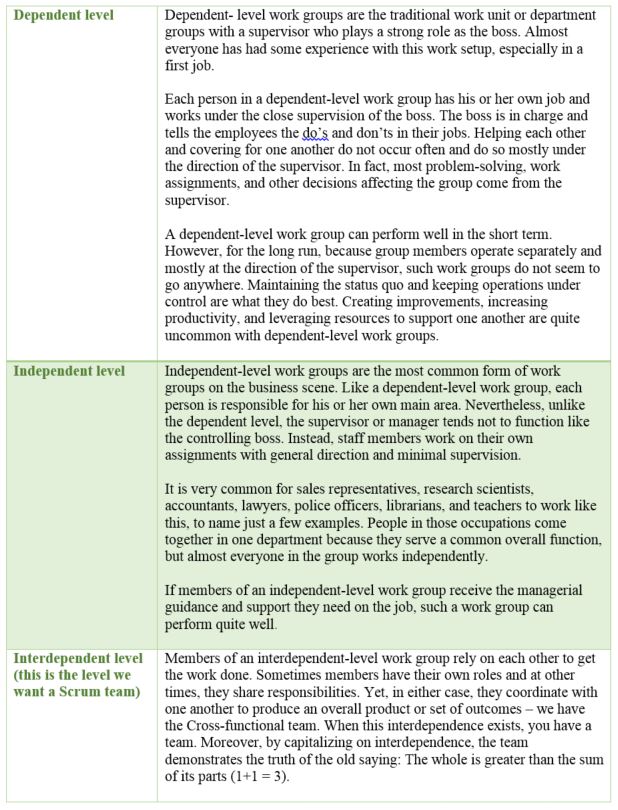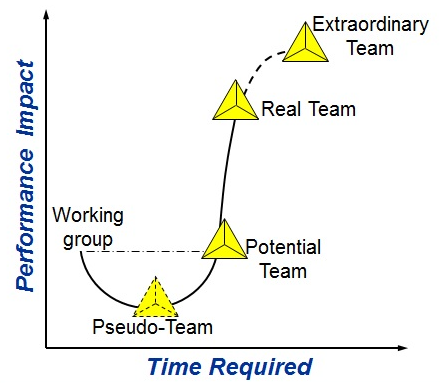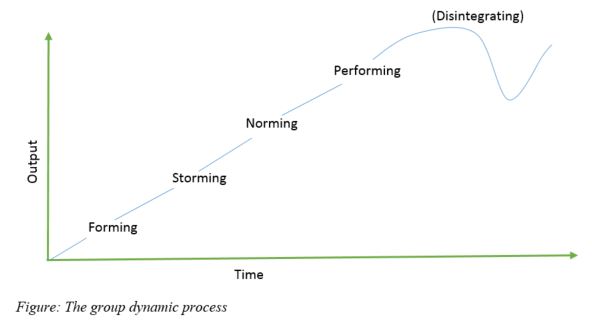Scrum.as - Blog
2015-05-28 - Beautiful team - Our team
1 Groups and teams
What is a real team? Let us explore what is different from a regular work group. In addition, we explore some of the factors that can give teams problems, and you will see why simply wishing a team to succeed does not guarantee anything. We will show you some models to guide you in building a strong team, and explain the skills that you want your team members to learn so that they can work well together.
Let us have a look at some differences between Groups and Teams:

Teams are a form of work group, but not all work groups are teams. What is the main difference between work groups that are teams and those that are not?
Work groups function on three levels:
- Dependent level
- Independent Level
- Interdependent Level

An independent work group can often be up to speed faster than an interdependent group (a team). It simply takes more time to get a group of individuals to work as a team than to set a group of individuals off on their independent assignments. Yet when teams move into a high-functioning and high-producing state, where they capitalize on interdependence, they can outperform all other types of work groups. So, if you want a quick fix, do not look to teams: but if you want to see strong results for the long term, do look to teams.
In "The Wisdom of Teams, New York, Hamer Collins, 1999" J. Katzenback & D. smith shows the transformation from working group to high performing teams, in the Team Performance Curve:

To call a group a team does not make them a team: wishing for them to work as a team doesn't work either. For a snapshot of the main differences between work groups and teams please look back to the table shown earlier in this chapter regarding the differences between groups and teams. As you can see, work groups have a strong individual focus and teams have a strong collective focus. The individual is not lost on a team, but person's work is coordinated to fit in with the greater good. Team concerns are more focused on the outcomes of the overall unit rather than an individual's accomplishments.
We want to build high performance team - we do Scrum, so why tell us about groups. Well, if you are an Advanced Scrum Master, you should know the differences, so you can build you team as strong as possible. So let us have a look at how the team dynamics process Works.
2 The group dynamic process - Tuckman
Bringing together a number of individuals to operate as a team or a group, do not start as a highly productive unit. They need time together, and they will go through a process of development involving a series of stages. Some groups goes through these rapidly and other never develop beyond a particular stage. Here your role as Advanced Scrum Master plays a significant part in this - you have to be aware for the stages, and you have to accept and adapt but at the same time educate and coach your team through different stages.
There are four broad stages through which teams develop, can often look like there are some overlap between stages. Tuckman was writing about them already in 1965:
- Forming
- Storming
- Norming
- Performing

It is important to understand this process because it happens to every group or team. Lots of teams never makes it to the "Norming" or "Performing" stages, often as a result of their manager blocking their progress. As an Advanced Scrum Master, you need to know, and not stopping teams going through storming phase. Instead, you can play a key role in facilitating the progress through these steps by understanding where the team is and adapting your style and approach to suit their needs.
Forming:
The team meets and learns about the opportunities and challenges, and then agrees on goals and begins to tackle the tasks. Team members tend to behave quite independently. They may be motivated but are usually relatively uninformed of the issues and objectives of the team. Team members are usually on their best behavior but very focused on themselves. Mature team members begin to model appropriate behavior even at this early phase.
The forming stage of any team is important because the members of the team get to know one another, exchange some personal information, and make new friends. This is also a good opportunity to see how members of the team work as an individual and how they respond to pressure.
Storming:
Tolerance of each team member and their differences should be emphasized; without tolerance and patience, the team will fail. This phase can become destructive to the team and will lower motivation if allowed to get out of control. Some teams will never develop past this stage; however, disagreements within the team can make members stronger, more versatile, and able to work more effectively as a team.
The Storming phase can become destructive to the team and will lower motivation if allowed to get out of control. Some teams will never develop past this stage. Supervisors of the team during this phase may be more accessible, but tend to remain directive in their guidance of decision-making and professional behavior. The team members will therefore resolve their differences and members will be able to participate with one another more comfortably. The ideal is that they will not feel that they are being judged, and will therefore share their opinions and views. Normally tension, struggle and sometimes arguments occur. This stage can also be upsetting.
Norming:
In this stage, all team members take the responsibility and have the ambition to work for the success of the team's goals. The danger here is that members may be so focused on preventing conflict that they are reluctant to share controversial ideas.
Performing:
By this time, they are motivated and knowledgeable. The team members are now competent, autonomous and able to handle the decision-making process without supervision. Dissent is expected and allowed as long as it is channeled through means acceptable to the team.
Supervisors of the team during this phase are usually participating. The team will make most of the necessary decisions. Even the most high-performing teams will revert to earlier stages in certain circumstances. Many long-standing teams go through these cycles many times, as they react to changing circumstances. For example, a change in leadership may cause the team to revert to storming as the new people challenge the existing norms and dynamics of the team.
Disintegration:
Eventually the team will come to an end. The project or task is completed, some people leave or new ones arrives. At this stage, look for an opportunity to reflect on that has gone well and celebrate success.
Thank the team members for what they have contributed and reflect on lessons learned. As this happens, plan for change as you move to a new team, new projects or whatever new structure you have to coach or lead.
3 Types of team
There are a number of types of team, which you might have in organization, and you need to coach or lead. The most common are as follows:
Work teams:
They are the most common and usually are ongoing. Work-unit teams are part of departments and have skills related to the department or work group's main function. Think of the customer service team, the accounting team, or the technical support team, for example. A work-unit team may not always have team in its name, but you can tell by the way team members work together and share accountability for an overall outcome that they are a classic team.
Projects teams:
This second most common type of team often is cross-functional, meaning it brings together a few special talents - or quite a few, if necessary - to accomplish a project. Everyone has a role, and everyone needs to work with everyone else to reach the right outcome. Often time-limited, project teams can disband when they complete their assignment. Nevertheless, in some technical fields, like engineering, the nature of the work is one project after another and people spend whole careers in team assignments, moving to a new project when they finish the last.
Focus teams:
Sometimes referred to as task forces (or even committees), focus teams usually are time-limited and cross-functional. Team members have skills related to the task: they are brought together to study challenging issues or critical problems facing the organization or overall department and to recommend action - and they are growing in use in many organizations. Sometimes task teams also implement their recommendations. Sometimes they are kept on call to respond to whatever arises, kind of like a volunteer fire department! Some task teams operate over long periods with members rotating in and out. The membership changes but the work of the team lives on.
Virtual teams:
As the name suggest, these teams have little or no direct personal contact. The team may be touching in to all of the other three, and almost certainly is a work team. The improvements in technology combined with moves towards remote working makes these a growing form of team. To become effective the remote teams need the leader to set a good example with their communication and relationship building. Once things are underway, there is scope to let go and share some of the leadership and responsibility in a similar way to the work teams.
More to come soon, but at www.Scrum.as you can find 100% agile education. This will be part of the coming Advanced Scrum Master.
Be part of our winning team - join us at www.Scrum.as
Author: Steen Lerche-Jensen
Copyright © 2018 - 2025 by Scrum.as // All Rights Reserved. // Privacy Policy






